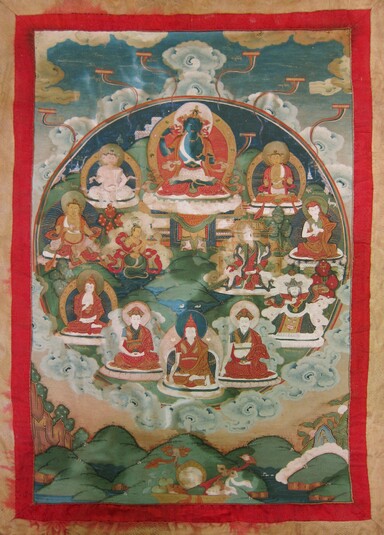
Item: Vajrapani (Bodhisattva & Buddhist Deity) - Bodhisattva
| Origin Location | Tibet |
|---|---|
| Date Range | 1800 - 1899 |
| Lineages | Nyingma and Buddhist |
| Material | Ground Mineral Pigment on Cotton |
| Collection | Private |
Classification: Deity
Appearance: Peaceful
Gender: Male
Vajrapani, Gods & Teachers. Five of these figures are the individuals believed to have received the Mahayoga and Anuyoga tantras of the Nyingma Tradition at the summit of Mount Malaya from Vajrapani. Known as the Five Excellent Ones of Sublime Nobility དམ་པའི་རིགས་ཅན་དྲ་མ་ལྔ་, they are:
- the god Yashasvi Varapala (Skt. Yaśasvī Varapāla; Wyl. grags ldan mchog skyong)
- the naga king Takshaka (Skt. Takṣaka; Wyl. klu rgyal 'jog po)
- the yaksha Ulkamukha (Skt. Ulkāmukha; skar mda' gdong)
- the rakshasa Matyaupayika (Skt. Matyaupāyika; Wyl. blo gros thabs ldan)
- the human being Licchavi Vimalakirti (Skt. Vimalakīrti; Wyl. dri med grags pa).
Alternatively, according to some sources, the god Indra (Wyl. rig 'dzin lha dbang brgya sbyin) is listed in place of Vimalakirti. In the painted composition above, the god Indra is not found however the god Brahma, yellow, with four faces, sits to the left side of Vajrapani.
The placement of the human teachers in the composition do not follow a chronological order but rather an unexplained hierarchical order. The figures in chronological order are:
- Licchavi Vimalakirti [14]
- King Dza [16]
- Nyag Lotsawa Yeshe Zhonnu, 8th century [17]
- Nubchen Sanggye, 9th century [18]
- Zurchen Shakya Jungne, 1002-1062 [20]
- Longchenpa Drime Ozer, 1308-1364 [21]
- Gyurme Dorje, 1646-1714 [19]
The twelve figures in the composition are arranged within a rainbow sphere. Above and outside of the circle bordered by blue and white clouds are six folio style texts with rainbow tails disappearing into the larger sphere. The six texts represent the Maha, Anu and Ati Yogas, along with the Kriya, Upa and Yoga Tantras.
Inside the central sphere are three geographic locations with Tibetan name inscriptions. They are Varanasi, Sitavana charnel ground and Meri Barwa. The last of these is a name often associated or substituted for the realm of Akanishta. It is possible that Meri Barwa is also a charnel ground name.
The most important figure of the composition is that of Vajrapani, blue in colour, seated on a throne and holding a vajra scepter in the upraised right hand. He is immediately accompanied on the right and left by a heavenly god, raksha, yaksha, naga and the famous King Dza. At the middle right side is the upasaka Vimalakirti made famous by the Vimalakirti Nirdesa Sutra.
The lower five figures are teachers of the Nyingma tradition: Nyag Lotsawa Yeshe Zhonnu, Nubchen Sanggye, Gyurme Dorje, Zurchen Shakya Jungne and Lonchen Drime Ozer.
Jeff Watt & Karma Gellek 9-2013
Inscriptions - Names & Subjects:
1. ཨ་ཏི་ཡོ་ག།
2. ཨ་ནུ་ཡོ་ག།
3. ཀྲི་ཡའི་རྒྱུད།
4. མ་ཧཱ་ཡོ་ག།
5. ཨུ་པ་ཡེ་ཡོ་ག།
6. ཡོ་ག་རྒྱུད།
7. ཝ་ར་ན་སི།
8. སྲེད་ཚལ།
9. མེ་རི་འབར་བ།
10. ཕྱག་ན་རྡོ་རྗེ།
11. སྲིན་པོ་བློ་གྲོས་ཐབས་ལྡན།
12. ཚངས་པ།
13. གནོད་སྦྱིན་རྟ་ཟླ།
14. ལི་ཙ་བི་དྲི་མེད་གྲགས་པ།
15. འཇོག་པོ།
16. རྒྱལ་པོ་ཛ།
17. གཉག་ལོ་ཙྭ་བ་ཡེ་ཤེས་གཞོན་ནུ།
18. གནུབས་ཆེན་སངས་རྒྱས།
19. གཏེར་གླིང་།
20. ཟུར་ཆེན་ཤཱཀྱ་འབྱུང་གནས།
21. ཀློང་ཆེན།
Buddhist Deity: Vajrapani, Bodhisattva (Non-iconic Figures)
Collection: Private 32
Tradition: Mindrolling (Nyingma)
Buddhist Deity: Vajrapani (Vajra Upraised)






